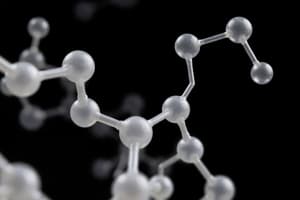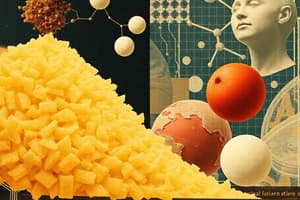Podcast
Questions and Answers
What elements are carbohydrates primarily composed of?
What elements are carbohydrates primarily composed of?
- C, N, and O
- O, H, and S
- C, H, and O (correct)
- C, H, and N
Which type of carbohydrate consists of more than 10 sugar units?
Which type of carbohydrate consists of more than 10 sugar units?
- Oligosaccharides
- Monosaccharides
- Polysaccharides (correct)
- Disaccharides
Which carbohydrate is primarily stored in the liver and muscles of animals?
Which carbohydrate is primarily stored in the liver and muscles of animals?
- Glycogen (correct)
- Starch
- Chitin
- Cellulose
What role do carbohydrates play in metabolism?
What role do carbohydrates play in metabolism?
Which of the following is NOT a classification of monosaccharides?
Which of the following is NOT a classification of monosaccharides?
Which describes the simplest form of carbohydrates?
Which describes the simplest form of carbohydrates?
Which carbohydrate type is involved in lowering blood glucose levels?
Which carbohydrate type is involved in lowering blood glucose levels?
Aldoses and ketoses differentiate monosaccharides based on what characteristic?
Aldoses and ketoses differentiate monosaccharides based on what characteristic?
What is the primary sugar found in blood?
What is the primary sugar found in blood?
Which monosaccharide is synthesized in the mammary gland to produce lactose?
Which monosaccharide is synthesized in the mammary gland to produce lactose?
Which of the following monosaccharides contains an asymmetric carbon atom?
Which of the following monosaccharides contains an asymmetric carbon atom?
What configuration indicates that the OH group is attached to the right side of the sub-terminal carbon?
What configuration indicates that the OH group is attached to the right side of the sub-terminal carbon?
Which of the following is an example of a heptose monosaccharide?
Which of the following is an example of a heptose monosaccharide?
What type of isomers differ only in the spatial arrangement of their identical chemical groups?
What type of isomers differ only in the spatial arrangement of their identical chemical groups?
What is a significant biological role of ribose?
What is a significant biological role of ribose?
Which of the following statements about asymmetric carbon atoms is true?
Which of the following statements about asymmetric carbon atoms is true?
Flashcards are hidden until you start studying
Study Notes
Carbohydrate Chemistry
- Carbohydrates are the most abundant form of organic matter on Earth. They are composed of carbon, hydrogen, and oxygen, and are produced through photosynthesis.
- Biological Importance of carbohydrates:
- Primary source of metabolic energy for plants and animals.
- Used to form key structural components like chitin in animals and cellulose in plants.
- Building blocks for other molecules, including fats, amino acids, and nucleic acids.
- Found in cell surface receptors, cell membranes, DNA, RNA, and vitamins B2 and C.
- Dietary fiber can help lower blood glucose and cholesterol levels, and prevent constipation.
- Sugars and other fermentable carbohydrates contribute to the action of oral bacteria, which can lower salivary pH and lead to tooth demineralization.
Carbohydrate Classification
- Carbohydrates are classified based on the number of sugar units in the chain:
- Monosaccharides: Single sugar unit (e.g., glucose, fructose, galactose)
- Disaccharides: Two sugar units (e.g., sucrose, lactose, maltose)
- Oligosaccharides: 3-10 sugar units
- Polysaccharides: More than 10 sugar units (e.g., starch, glycogen, cellulose)
Monosaccharides: Building Blocks of Carbohydrates
- Monosaccharides are the simplest forms of carbohydrates.
- Classification of Monosaccharides
-
Based on the presence of an aldehyde or ketone group:
- Aldoses: Contain an aldehyde group.
- Ketoses: Contain a ketone group.
-
Based on the number of carbon atoms in the backbone:
- Trioses: 3 carbons (e.g., glyceraldehyde, dihydroxyacetone).
- Tetroses: 4 carbons.
- Pentoses: 5 carbons (e.g., ribose, deoxyribose, xylose, ribulose).
- Hexoses: 6 carbons (e.g., glucose, fructose, galactose, mannose).
- Heptoses: 7 carbons.
-
Based on the number of carbon atoms and active group:
Number of Carbons Aldoses Ketoses Trioses Glyceraldehyde Dihydroxyacetone Tetroses Erythrose Erythrulose Pentoses Ribose, Xylose Ribulose, Xylulose Hexoses Galactose, Glucose, Mannose Fructose Heptoses Heptose Sedoheptulose
-
Biological Importance of Monosaccharides
- Ribose is a component of ribonucleic acid (RNA).
- Deoxyribose is a component of deoxyribonucleic acid (DNA).
- Glucose is the sugar found in blood.
- Fructose is the sugar found in semen.
- Galactose is synthesized in the mammary gland to make lactose (milk sugar).
- Mannose is a constituent of many glycoproteins.
Configuration of Monosaccharides
- Asymmetric Carbon: A carbon atom attached to four different chemical groups.
- Stereiosomers: Compounds with the same chemical formula but different spatial arrangement of their atoms.
- D and L Forms:
- D-sugars: Have the hydroxyl group (OH) on the subterminal carbon atom on the right side.
- L-sugars: Have the hydroxyl group (OH) on the subterminal carbon atom on the left side.
- Almost all naturally occurring carbohydrates are D-configuration.
Studying That Suits You
Use AI to generate personalized quizzes and flashcards to suit your learning preferences.




